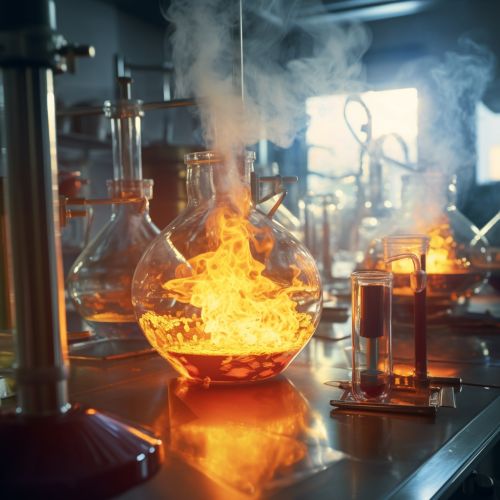Chemical kinetics
Introduction
Chemical kinetics, also known as reaction kinetics, is the study of rates of chemical processes. This discipline within physical chemistry is concerned with understanding the speeds, or rates, at which reactions occur to help predict the kinetics of chemical reactions.
Fundamentals of Chemical Kinetics
Chemical kinetics involves the study of how different experimental conditions can influence the speed of a chemical reaction and yield information about the reaction's mechanism and transition states. It is also used to understand the connections between reactive molecules, the formation of intermediates, and the rearrangement of atoms in the process of a chemical reaction.


Rate of Reaction
The rate of a chemical reaction is defined as the change in concentration of a reactant or product per unit time. Rates are often expressed in terms of the concentration of the reactant disappearing or product appearing in the time interval. The rate of reaction can be influenced by various factors such as concentration, temperature, surface area, and the presence of a catalyst.
Reaction Order
In chemical kinetics, the reaction order is the sum of the power dependence of the rate of reaction on the concentration of each species in the reaction. The reaction order can be zero, first, second, or any positive integer value and is determined experimentally. The order of a reaction is a critical part of the rate equation, which predicts the rate of reaction under specific conditions.
Rate Equation
The rate equation is a mathematical representation of a chemical reaction that links the reaction rate with concentrations or pressures of reactants and constant parameters. The rate equation varies depending on the mechanism of the reaction and can be derived theoretically using the transition state theory or from experimental data.
Collision Theory
The collision theory is a model for explaining chemical reactions and reaction rates using the interactions of particles within a certain system. The theory posits that for a reaction to occur, not only must particles collide, but they must also possess a certain minimum amount of kinetic energy, known as the activation energy.
Transition State Theory
Transition state theory, or activated complex theory, is a theory that explains the reaction rates of elementary chemical reactions. The theory assumes a special type of chemical equilibrium (quasi-equilibrium) between reactants and activated transition state complexes.
Arrhenius Equation
The Arrhenius equation is a mathematical formula that describes how the rate of a chemical reaction depends on the temperature. It provides a quantitative basis for the temperature dependence of reaction rates and is a fundamental equation in the study of chemical kinetics.
Catalysts and Catalysis
In chemical kinetics, a catalyst is a substance that can alter the rate of a chemical reaction without being consumed or changed in the process. Catalysts work by lowering the activation energy for a reaction, thereby increasing the rate of the reaction.
Enzyme Kinetics
Enzyme kinetics is the study of the chemical reactions that are catalyzed by enzymes. In enzyme kinetics, the reaction rate is measured and the effects of varying the conditions of the reaction are investigated.
Applications of Chemical Kinetics
Chemical kinetics has a wide range of applications in chemistry, physics, and engineering. It is used in the study of reaction mechanisms, the design of chemical reactors, the interpretation of spectroscopic data, and in the understanding of environmental processes.
